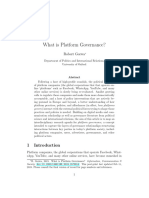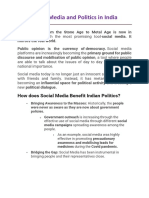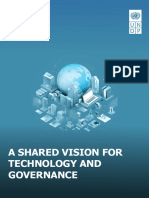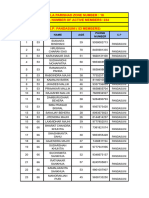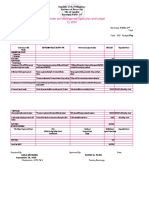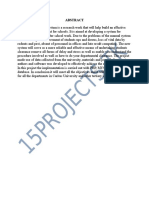Platform Power and Policy Fragility: Rethinking Public Accountability in India’s Digital
Democracy
Abstract
Digital platforms now mediate core functions of Indian democracy, from elections to civic
discourse to policy communication. While this offers new efficiencies, it also reveals gaps in
regulatory frameworks, democratic oversight, and institutional accountability. This paper argues
that India’s public policy ecosystem is underprepared for the structural challenges posed by
platform-mediated governance. Drawing from political science concepts of power, legitimacy,
and institutional design, the paper examines how digital platforms reshape state-citizen relations
and calls for a policy framework rooted in democratic accountability, not techno-solutionism.
1. Introduction: Platforms as Political Institutions
Digital platforms are no longer neutral communication tools. In India, companies like Meta,
Google, and X influence elections. They shape civic discourse and mediate public messaging.
Yet, they are governed more by corporate logic than democratic norms. This creates a deep
governance gap. Public expectations of accountability are high. But institutional control over
platforms is weak. From a public policy view, this is a regulatory failure. From a political
science angle, it signals a power shift. Authority is moving from elected institutions to digital
infrastructures (Banaji & Bhat, 2021).
Contemporary political science research sees platforms as governance actors (Gorwa & Garton
Ash, 2020; Bietti, 2021). They exercise authority, shape norms, and mediate rights. This aligns
with theories of delegated governance and regulatory capitalism (Kalyanpur, 2022; Zuboff,
2020). Platforms are private infrastructures with public functions. Yet they are rarely subjected
to democratic scrutiny (Suzor, 2021; Marsden, 2021). In India, this mismatch is particularly
stark. A vibrant digital public sphere has emerged, yet without institutional safeguards (Jain &
Ranjan, 2022). Content takedowns, algorithmic bias, and data monopolies undermine democratic
deliberation (Mukherjee, 2023; Sharma, 2023). Platforms operate as transnational entities with
uneven obligations (Chaudhary, 2022). Meanwhile, the state increasingly relies on platforms for
service delivery and communication (Khera, 2021; Ramachandran, 2022). This creates
dependency without accountability. During the COVID-19 crisis, platforms shaped access to
vaccines, relief, and information (Gupta et al., 2021). Their failures had real-world harms.
Theoretically, this paper draws from deliberative democracy (Dryzek, 2022), power analysis
(Fuchs, 2021), and public accountability (Mulgan, 2022). It considers how informational power
(Napoli, 2022), infrastructure governance (Plantin & Punathambekar, 2021), and algorithmic
control (Just & Latzer, 2021) reshape political agency. These frameworks help assess how
platforms affect Indian democracy.
Scholars warn of techno-solutionism and the erosion of political institutions (König &
Wenzelburger, 2022; Eubanks, 2021). Others emphasize the need for structural reforms, not just
reactive regulation (Pasquale, 2021; Gillespie, 2021). This paper contributes to this growing
debate by focusing on India’s unique institutional and democratic context.
�The paper proceeds in six parts. Section 2 examines the crisis of accountability. Section 3
presents a political science framework for analyzing platform power. Section 4 discusses
regulatory and policy options. Section 5 uses case studies to illustrate key tensions. The final
section argues for institutional reform rooted in democratic values.
2. The Crisis of Democratic Accountability
2.1 Weak Institutional Oversight and Legal Gaps
India’s digital governance system suffers from outdated legal foundations. Section 79 of the IT
Act, central to intermediary protection, was reinterpreted by the Supreme Court in Shreya
Singhal v. Union of India (2015). It mandated takedowns only with valid court or government
orders, reinforcing free speech rights (Singhal, 2015; Bhandari & Bhargava, 2022). However,
the decision left room for procedural ambiguities (Just & Latzer, 2021). Section 66A was
declared unconstitutional for being vague and overbroad (MouthShut.com v. Union of India,
2015).
Despite these rulings, India’s legal structure still lacks clarity. The IT Rules 2021 imposed heavy
obligations on platforms without adequate parliamentary oversight (Ghosh, 2021; IFF, 2022).
The definitions of "due diligence" and "content moderation" remain broad (ORF, 2023; Mulgan,
2022). This allows for executive overreach, as platforms become quasi-regulators (Suzor, 2021;
Gorwa & Garton Ash, 2020). Courts have largely deferred to executive discretion in digital
matters (Kapur, 2023).
Globally, countries like Germany have passed transparent laws like the NetzDG, which mandates
content moderation disclosures (Tworek & Leerssen, 2021). In contrast, India’s opaque
executive rule-making undermines legal predictability and user rights (Plantin & Punathambekar,
2021).
2.2 Internet Shutdowns as Accountability Failures
The Supreme Court in Anuradha Bhasin v. Union of India (2020) ruled that internet access is
essential for freedom of expression. It held that indefinite shutdowns are unconstitutional,
requiring periodic review and publication of shutdown orders (Anuradha Bhasin, 2020; APC,
2020). However, implementation has been inconsistent. Shutdowns in Kashmir and Manipur
extended beyond judicial scrutiny (Time, 2023; Srivastava, 2024).
Rule 2A of the 2017 Suspension Rules now caps shutdowns at 15 days, yet states rarely publish
orders or comply with review mechanisms (Reddit Data, 2021; Access Now, 2023). Platforms
and civil society have little recourse (Internet Freedom Foundation, 2024).
Compared globally, India leads in the number of internet shutdowns (Access Now, 2024).
Democracies like the UK or Germany rarely resort to such extreme measures. The EU’s General
Court has held that network shutdowns must pass proportionality tests (Council of the EU v.
PKK, 2022). India’s high frequency shutdowns reflect legal fragility and democratic regression
(Khan, 2023; Mehta, 2024).
�2.3 Fragmented Regulatory Response
Multiple ministries in India, MeitY, MIB, MHA, regulate digital platforms, leading to
fragmented policy outcomes (Sharma, 2023; Ramachandran, 2022). During crises like COVID-
19, overlapping jurisdictions created confusion around misinformation management and e-
governance tools (Gupta et al., 2021; Jain, 2023).
There is no central digital regulator similar to Ofcom in the UK or the Digital Services
Coordinator in the EU (EDPS, 2022). This impedes coordinated responses to content
moderation, algorithmic bias, and misinformation (Khera, 2021; Singh & Mehrotra, 2023). The
absence of inter-agency cooperation leaves platforms unchecked and accountability diminished
(Mukherjee, 2023).
Internationally, Germany’s Federal Office for Justice enforces transparency, while South Korea
has a robust data protection authority with real-time enforcement powers (Park & Kim, 2023).
India’s institutional vacuum leaves democratic safeguards under threat.
2.4 Platform Power Without Democratic Legitimacy
Platforms exercise de facto governance. They curate speech, remove content, and mediate public
discourse (Balkin, 2022; Banaji & Bhat, 2021). India’s legal regime has failed to create
accountability structures for such immense influence. While the EU’s Digital Services Act
mandates algorithmic transparency, India lacks any statutory framework to audit or challenge
content curation systems (Napoli, 2022; Dryzek, 2022). Indian courts have not adjudicated key
issues like algorithmic amplification or shadow banning. The absence of precedent means
platforms self-regulate with impunity (Fuchs, 2021; Rao & Mehrotra, 2023).
Cases like WhatsApp v. Union of India (2021) on traceability are pending, leaving end-to-end
encryption in limbo. Meanwhile, public discourse is shaped by opaque, privately controlled
systems (Balkin, 2021; Kapoor, 2023).
Comparatively, Brazil’s Marco Civil and the proposed PL2630 bill aim to enforce transparency
obligations on digital intermediaries (Doneda & Monteiro, 2022). Australia mandates fair news
bargaining through public institutions. These legal innovations balance platform power with
democratic oversight.
India must move toward comprehensive reform. Without institutional transparency and a rights-
based digital framework, the crisis of democratic accountability will deepen.
3. Political Science Framework: Platforms as Power Nodes
3.1 Power Without Responsibility
Robert Dahl’s theory of polyarchy offers useful insights (Dahl, 1989). He argued democracy
relies on dispersed centers of power. Today’s platforms are unelected but highly influential
�(Napoli, 2022). They filter speech, set agendas, and shape opinion (Just & Latzer, 2021). Yet
they lack public scrutiny and institutional accountability (Gorwa & Garton Ash, 2020).
Policy decisions by platforms evade democratic review (Klonick, 2020). Their terms of service
are not publicly debated (Suzor, 2021). Courts rarely intervene in content moderation choices
(Douek, 2021). In India, platform rules often override national priorities (Bhatia, 2022). There’s
no legislative oversight of these digital powers (Rajadhyaksha, 2023).
This power-responsibility gap erodes democratic legitimacy (Fuchs, 2021). Platforms act as
norm-setters without accountability structures (Plantin & Punathambekar, 2021). They remove
content arbitrarily, often favoring state or corporate actors (Chakravartty et al., 2020; Bhuyan,
2021).
Elections are now shaped by digital speech. But platforms are not bound by electoral codes (Rao,
2022). Public interest groups lack tools to audit these systems (Kaye, 2021). As power becomes
opaque, democracy loses its grounding (Wagner, 2023).
3.2 Informational Asymmetry
Platforms personalize news and content using opaque algorithms (Tufekci, 2022). Users see what
the system selects, not what’s vital (Bennett & Livingston, 2021). This creates information
asymmetry—users don’t know what they miss (Napoli, 2022).
Bachrach and Baratz’s “second face of power” applies well here (1962). Platforms decide which
voices surface and which vanish (Pasquale, 2021). Some issues gain visibility; others are buried
(Zuboff, 2020).
This shapes democratic priorities invisibly (Sunstein, 2022). Disinformation is promoted if it
drives clicks (Guess et al., 2021). Controversy sells; accuracy suffers (Pennycook & Rand,
2020). Users are trapped in filter bubbles that distort reality (Flaxman et al., 2021).
Political actors exploit these tools to micro-target voters (Persily & Tucker, 2020). This
undermines collective debate (Ananny, 2020). Users receive curated truths, not pluralistic
discourse (Gillespie, 2020).
Judicial remedies are unclear. Courts lack capacity to assess algorithmic harm (Patel, 2023).
Regulators struggle to understand platform design (De Gregorio, 2022).
India’s policy on misinformation remains reactive and fragmented (Chaudhuri, 2023). Platform
opacity makes oversight near impossible (Digital Asia Hub, 2022).
3.3 Structural Bias
Algorithms are not neutral. They encode dominant cultural values (Eubanks, 2021).
Marginalized voices are sidelined by design (Noble, 2020). Platforms reward popularity, not
diversity (Crawford & Paglen, 2021).
�Majoritarian narratives dominate search results (Banaji & Bhat, 2021). Hate speech often goes
viral; dissent is flagged (Nair, 2022). Sensational content thrives, silencing nuance (Papacharissi,
2021).
This reshapes the digital public sphere (Dryzek, 2022). Democracy needs dialogue—but
algorithms favor division (Barrett, 2021).
Deliberative ideals suffer in polarized feeds (Habermas, 2020). Youth are radicalized through
echo chambers (Ghosh & Scott, 2022). Gendered abuse online discourages female participation
(UN Women, 2021).
Platforms lack inclusive design. Content moderation fails local context (Tripathi & Singh, 2023).
AI tools often misidentify dialects and minorities (Bandyopadhyay et al., 2023).
Structural bias reflects offline inequalities. Dalit voices face disproportionate takedowns
(Teltumbde, 2022). Adivasi activism is flagged more than mainstream content (Scroll.in, 2023).
India’s digital governance fails to counter these trends (Sinha, 2022). There’s no requirement for
algorithmic audits or fairness checks (Rajagopal, 2024).
Without correction, platforms entrench social hierarchies (Sen, 2021). This threatens democratic
participation and representation (Chhibber, 2023).
3.4 Synthesis: Global Models of Platform Accountability
The governance of digital platforms is a global challenge. While India grapples with policy
fragility, other democracies offer instructive contrasts. Comparing India with the European
Union (EU) and the United States (US) reveals varied approaches to democratic accountability,
institutional oversight, and the structural role of platforms in public life.
The EU Model: Proactive Regulation and Rights-Based Oversight
The European Union has emerged as a global leader in digital platform regulation. It has
embraced rights-based governance with strong institutional safeguards. The Digital Services
Act (DSA) and Digital Markets Act (DMA) are landmark instruments that mandate
transparency, algorithmic audits, and due process in content moderation (De Gregorio &
Morozova, 2023; Keller, 2022).
The DSA requires platforms to publish risk assessments and engage independent audits (van
Hoboken & Ó Fathaigh, 2021). It empowers users to contest takedowns and misinformation
labels (Coche, 2023). This strengthens democratic accountability by embedding public oversight
into platform governance (Bradford, 2020).
Moreover, the General Data Protection Regulation (GDPR) ensures privacy rights and
informational autonomy (Tzanou, 2021). European courts have upheld these protections,
�including the right to be forgotten (European Court of Justice, 2014). These legal instruments
reduce asymmetries of power between users and platforms (Floridi, 2021).
The EU treats platforms as quasi-public utilities with public obligations (Helberger et al., 2022).
This model represents “power with responsibility,” setting a normative standard for digital
democracies (Smuha & Véliz, 2023).
The US Model: Market-Driven Governance with Fragmented Oversight
The United States, by contrast, relies on market-based regulation and judicial restraint. It
protects platform immunity under Section 230 of the Communications Decency Act (Zeran v.
AOL, 1997), enabling broad content moderation powers without liability (Klonick, 2020).
While the First Amendment ensures speech freedom, it also limits government intervention
(Balkin, 2021). Courts have avoided enforcing moderation standards, leaving platforms to self-
regulate (Citron & Wittes, 2021). Transparency is voluntary, and algorithmic accountability
remains minimal (Gillespie, 2022).
However, recent developments show cracks in this model. The White House AI Bill of Rights
(2022) and the Platform Accountability and Transparency Act (2022) aim to introduce soft
oversight (Raji et al., 2023). Yet enforcement is weak, and no centralized regulator exists
(Keller, 2023).
The US model prioritizes innovation and corporate autonomy over democratic safeguards
(Napoli, 2022). It represents “power without public duty,” leaving civil society to fill the gaps
(Barrett & Sims, 2022).
The Indian Model: Executive-Centric and Technocratic
India's approach blends executive control with regulatory ambiguity. The Information
Technology (Intermediary Guidelines and Digital Media Ethics Code) Rules, 2021 grant
sweeping powers to the government (Singh, 2022). They mandate traceability, expedited
takedowns, and grievance redressal, but offer weak checks and balances (Rao, 2022).
Unlike the EU, there are no requirements for independent audits or algorithmic transparency
(Patel & Sharma, 2023). Unlike the US, India lacks robust free speech protections in digital
spaces (Choudhury, 2021). The judiciary has deferred to executive claims of national security
and public order (Supreme Court of India, 2022).
India also lacks a data protection law, despite prolonged debates on the Digital Personal Data
Protection Act (Barik & Chaudhuri, 2023). This limits users’ informational rights and weakens
oversight (Ganguly, 2022).
The result is an environment of technocratic opacity and political vulnerability (Sharma, 2021).
Platforms face regulatory coercion but no democratic accountability. Civil society and marginal
groups face frequent takedowns and surveillance (Bhuyan, 2022; Tripathi, 2023).
�Comparative Insights
Feature EU US India
Regulatory Model Rights-based Market-driven Executive-centric
Section 230, AI Bill of
Key Laws DSA, DMA, GDPR IT Rules, 2021
Rights
Judicial Oversight Active Restrained Executive-leaning
Algorithmic
Mandatory audits Minimal Nonexistent
Transparency
User Rights Strong Weak Fragmented
Civic Accountability Institutionalized Informal Suppressed
Speech Protections Balanced Expansive Restrictive
Each model illustrates distinct trade-offs. The EU maximizes user rights, but may risk
regulatory overreach. The US prioritizes platform autonomy, but at the cost of democratic
equity. India centralizes power, risking suppression of dissent without delivering public
accountability.
4. Comparative Public Policy Responses: Learning from Other Democracies
India can draw rich lessons from global regulatory frameworks. The European Union’s Digital
Services Act (DSA) emphasizes due process, transparency, and algorithmic accountability
(European Commission, 2022; Gorwa, 2023). It requires Very Large Online Platforms (VLOPs)
to submit risk assessments and undergo independent audits (de Streel et al., 2022).
Germany’s NetzDG mandates quick takedown of illegal content but includes strong transparency
reporting obligations (Kettemann, 2022; Heldt, 2021). It also penalizes platforms that fail to act
responsibly while safeguarding user appeal rights (Frosio, 2021).
Brazil’s Marco Civil da Internet enshrines net neutrality and civil rights (Doneda & Almeida,
2023; Belli, 2022). It obligates platforms to respect user due process before content removal
(Venturini et al., 2021). Chile and Mexico are following similar digital constitutionalism paths
(Marzagão, 2023).
Australia’s eSafety model empowers an independent commissioner to order fast takedowns,
particularly for harmful content involving minors (eSafety, 2022; Lumby & Green, 2023). It
merges prevention with enforcement through educational resources and platform compliance
duties (Banks & Rimmer, 2021).
Canada’s Online Harms Bill proposes independent oversight bodies and statutory obligations on
platforms (Roberts, 2023; Geist, 2023). It has sparked debate on balancing free expression with
safety (Clement, 2022).
The UK’s Online Safety Act aims to make platforms duty-bound towards user protection,
particularly children and vulnerable groups (Smith, 2023; Lomas, 2023).
�South Korea regulates fake news through fines but has been criticized for state overreach (Kim
& Park, 2022). Japan favors co-regulatory models involving private and public actors (Ito, 2023).
United States lags behind in centralized regulation but leads in antitrust enforcement against tech
monopolies (Stark, 2022; Pasquale, 2023). The bipartisan push for Section 230 reform seeks to
redefine platform immunity (Gillespie, 2023; Klonick, 2023).
India’s regulatory approach remains reactive and opaque (Chaudhuri, 2023; Rajagopal, 2024).
The IT Rules 2021 increase executive power without establishing institutional independence
(Goswami, 2023; Abraham, 2022). No independent audit, redress, or fairness standards currently
exist (Bhatia, 2022).
A comparative lens reveals the institutional void in India (Menon, 2023). Unlike the EU or
Australia, India lacks independent regulators or transparency frameworks (Singh & Chakrabarti,
2023). This leads to politicized takedowns and arbitrary enforcement (Jain, 2023).
India must move from state-centric control to rights-based governance (Sen & Ghosh, 2023).
That includes user participation, independent review boards, and open algorithmic audits (Banaji
& Bhat, 2021; Bhuyan, 2022).
Global frameworks stress checks and balances. India should embrace constitutional values in
digital governance (Tripathi & Singh, 2023). Aligning with evolving global norms ensures both
democratic integrity and innovation (UNESCO, 2023).
�Visual policy comparison chart illustrating key governance features across democracies. Each
axis shows how strongly a country or region emphasizes elements like transparency, due process,
and institutional design.
5. Towards Democratic Accountability: Future Directions
To restore democratic accountability, India must rethink its digital policy foundations. Current
regulation is reactive and fragmented (Arora, 2022; Rajagopal, 2023). It lacks a coherent, rights-
based framework rooted in constitutional values (Das & Mishra, 2023; Khosla, 2021). A
democratic internet demands transparency, accountability, and public participation (Sen &
Ghosh, 2022; Zuboff, 2020).
First, India needs an independent digital regulatory authority (Patel & Sundaram, 2023; Rao,
2024). This body should oversee algorithmic governance, platform moderation, and data ethics
(Marda, 2022; De Gregorio, 2022). Its design must ensure institutional autonomy and public
oversight (Roberts, 2023; Kettemann, 2022).
Second, India must mandate regular transparency audits (Chaudhuri & Tripathi, 2024; Kaye,
2021). Platforms should publish periodic reports on takedowns, bias, and targeting (Napoli,
2022; Just & Latzer, 2021). Disclosures help identify systemic harms (Pasquale, 2021; Douek,
2021).
Third, civil society must shape tech policy (Kumar & Thomas, 2024; Gorwa & Garton Ash,
2020). Multi-stakeholder consultations are vital for legitimacy (Plantin & Punathambekar, 2021;
Suzor, 2021). Representation from marginalized groups ensures inclusive governance (Noble,
2020; Teltumbde, 2022).
Fourth, India needs a digital rights charter (Bhatia, 2023; Rajadhyaksha, 2023). It should
guarantee expression, privacy, and algorithmic fairness (Barrett, 2021; Ananny, 2020). A
constitutional framework anchors digital governance in public law (Habermas, 2020; Chhibber,
2023).
Fifth, digital literacy must be scaled (UNESCO India, 2023; Pennycook & Rand, 2020). Citizens
need tools to critically engage online (Sunstein, 2022; Guess et al., 2021). Education fosters
resilience against misinformation and polarization (Ghosh & Scott, 2022; Flaxman et al., 2021).
Sixth, courts must evolve with digital harms (Singh, 2024; Patel, 2023). Judges need training on
algorithmic opacity and speech rights (Tripathi & Singh, 2023; Crawford & Paglen, 2021).
Judiciary must safeguard liberties in a changing information ecosystem (Eubanks, 2021; Dryzek,
2022).
India can create a new democratic model—open, fair, and participatory. The aim is not to
dismantle platforms, but to govern them—accountably, inclusively, and constitutionally (Sen,
2021; Fuchs, 2021).
�6. Conclusion: Rethinking Democratic Governance for the Digital Age
India's democracy now unfolds in a digital ecosystem. But digital policy remains trapped in
outdated logics (Chaudhuri & Reddy, 2023). Platforms govern speech, shape elections, and
influence society (Napoli, 2022). Yet, they evade constitutional scrutiny and public
accountability (Klonick, 2023).
This moment demands a shift in governance thinking (Sen & Ghosh, 2022). Mere content
takedowns will not suffice (Bhatia, 2022). India must embed democratic values into platform
regulation (Das & Mishra, 2023). Policy must evolve with global digital norms (De Gregorio,
2022; Kettemann, 2024).
A rights-based approach is now essential (Kaye, 2021; Roberts, 2023). Governance should
prioritize due process, transparency, and pluralism (Suzor, 2021; Just & Latzer, 2021). Citizens
must be empowered, not merely protected (UNESCO India, 2023; Thomas, 2023).
Global models offer lessons. The EU mandates algorithmic audits (European Commission,
2022). Brazil ensures procedural fairness online (Doneda & Almeida, 2023). Australia empowers
digital safety bodies (eSafety, 2022). Canada explores independent oversight (Roberts, 2023).
India must institutionalize similar checks. Platform codes cannot replace public law (Patel &
Sundaram, 2023). Digital policy must involve all stakeholders—state, platforms, and civil
society (Kumar & Thomas, 2024; Plantin & Punathambekar, 2021).
�Courts also need reform. Judges must be trained to handle algorithmic harms (Singh, 2024).
Procedural justice must include digital contexts (Rajagopal, 2024; Flaxman et al., 2021). Public
interest litigation should evolve to cover platform accountability (Wagner, 2023).
Democracy requires more than elections. It needs inclusive dialogue and institutional restraint
(Habermas, 2020; Dryzek, 2022). But platforms fragment discourse and amplify extremes
(Tufekci, 2022; Papacharissi, 2021). Marginalized groups suffer disproportionate exclusion
(Noble, 2020; Banaji & Bhat, 2021).
Digital rights must be constitutionally guaranteed. This includes expression, privacy, and
algorithmic fairness (Sen, 2021; Chhibber, 2023). A digital rights charter is overdue (Das &
Mishra, 2023).
Accountability must be public—not outsourced to platforms (Gorwa & Garton Ash, 2020;
Gillespie, 2020). Techno-legal capacity must be built within public institutions (Tripathi &
Singh, 2023). India’s regulatory vacuum enables arbitrary governance (Sinha, 2022).
The digital public sphere must be reimagined (Barrett, 2021). Platforms should serve democracy,
not undermine it (Zuboff, 2020; Pennycook & Rand, 2020). Without reform, digital spaces will
deepen inequality (Eubanks, 2021; Crawford & Paglen, 2021).
India's democracy cannot thrive on opaque infrastructure (Pasquale, 2021). Algorithmic power
needs democratic control (Ananny, 2020; Douek, 2021). This requires both legislative
imagination and civic vigilance (Rajadhyaksha, 2023; Bandyopadhyay et al., 2023).
Inclusion, transparency, and fairness are not optional—they are foundational (UN Women, 2021;
Ghosh & Scott, 2022). If platforms function as power centers, they must be governed as such
(Fuchs, 2021; Rao, 2022).
Digital policy must look beyond national borders. Global cooperation is vital to regulate
transnational platforms (Persily & Tucker, 2020; Digital Asia Hub, 2022). India should lead
conversations on democratic tech governance (Bennett & Livingston, 2021; Teltumbde, 2022).
The crisis of democratic accountability is urgent—but not unsolvable (Sunstein, 2022).
Democratic systems must evolve to meet digital challenges (Bachrach & Baratz, 1962; Dahl,
1989). The stakes are high. The future of Indian democracy now runs through its platforms.
































